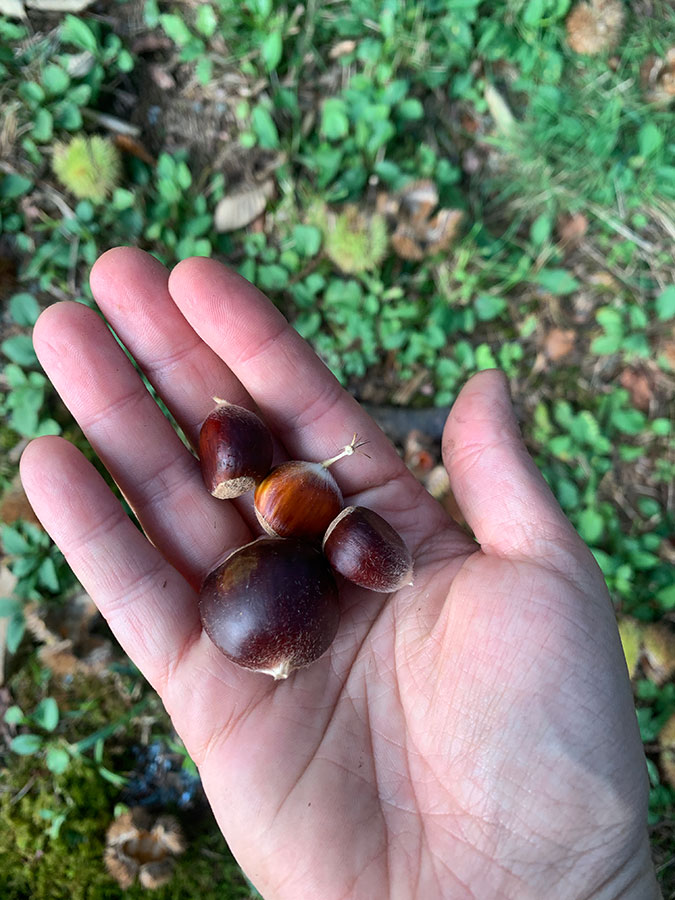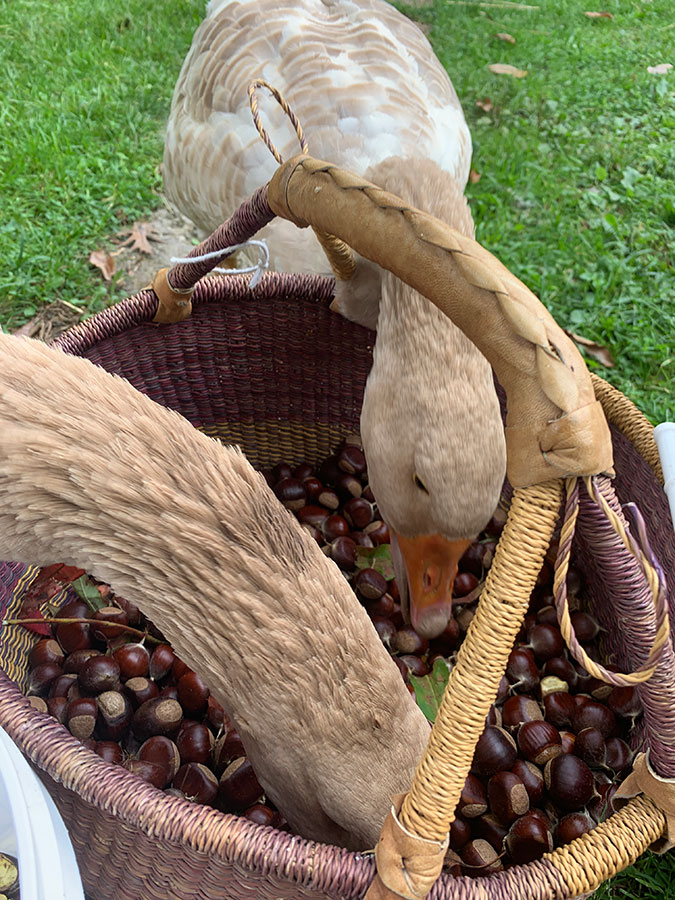
Just a few weeks ago, I went and checked the local chestnut trees that are in a field near where I live. Ever since I moved to the new homestead, I have been eagerly visiting these trees. Last year, they dropped plenty of husks but with only shriveled nuts inside. This year, I was extraordinarily pleased to find that both trees had produced a bumper crop of the delicious nuts–some almost 2″ across, but most smaller, almost all worm-free, and delicious. I eagerly filled my basket with the nuts, stepping carefully around the extremely prickly husks. I sat with each of the trees and we conversed as I harvested the nuts. I took home 25 lbs of nuts that day, and these nuts will sustain myself, my geese (who love them), and my friends and family for many a Samhain, Thanksgiving, and Yule feast! Chestnut trees have many lessons to teach us. Even after the way they have been treated here in the US over the last few centuries, they are still kind, abundant, and wise. So today, let’s explore the magic of the chestnut tree, trees that certainly come into their power this time of year (here, in the mid-to-late fall) as their protective husks suddenly open and their abundance comes forth.
This is a part of my Sacred Trees in the Americas series, which is my long-running series where I focus on trees that are dominant along the Eastern seaboard of the US, including in Western PA, where I live. Previous trees in this series have included: Cherry, Juniper, Birch, Elder, Walnut, Eastern White Cedar, Hemlock, Sugar Maple, Hawthorn, Hickory, Beech, Ash, White Pine, and Oak. Today we are talking about the American chestnut, Castanea dentata.
History and Hope
Chestnut is a tree with a complex history in North America. One of the better sources–and delightful reading–about the history of chestnut comes from Eric Sloane’s On Reference of Wood. Prior to white colonization, chestnut was one of the most abundant trees (making up about 25% of the total tree cover, which is an enormous amount of tree cover for one species). These abundant and giving trees reached up to the tops of the tree canopy, and I’m sure, were incredibly majestic to behold. Native American peoples depended on them, and cultivated them, as a serious food crop. Unlike acorns, which take a lot of processing (especially those we have here on the US east coast) chestnuts require practically no processing and are a rich source of nutrients and carbohydrates.
At the time of colonization, chestnut wood was put to use as a sturdy and rot-resistant building material; in fact, many of the old barns here that date before the 1900s have rafters and beams made of solid, strong chestnut. Like many other trees, with colonization came the cutting down of the largest of the chestnuts for wood purposes. But the tragic history of Chestnut doesn’t end there. In 1904, the Chestnut blight (Endothia parasitica) swept across North America. Grimm described the decline of chestnuts as “the gaunt skeletons of great trees in our forests.” Eric Sloane talks about this in a similar way–chestnuts were once a very dominant tree among our landscapes, with massive trunks and tall branches and crowns, reaching into the heavens. After they died back, they left skeletons everywhere.
Here in Pennsylvania, something even worse happened. Here in PA, as a political move being claimed in the name of stopping the blight, the PA Forestry division ordered every last chestnut cut down. So to stop the blight…you eradicate the species? That’s right. Rather than see if some trees could develop disease resistance, instead, they cut down to the very last tree. If you look at this map, you will see how impactful that decision was on the number of chestnut trees. My own interpretation of this, giving when it happened, is that by this time, about 90% of the forest cover was lost in Pennsylvania already. This was an easy excuse for even more logging to fuel growing industrialization and demands for wood. By the 1940s, the American chestnut was all but extinct. Thus, within less than forty years, between four and six billion American Chestnuts were gone.

Fortunately, this is not where history ends. In the late 20th and early 21st century, Chestnut is seeing a resurgence. First, we have organations like the American Chestnut Foundation who conduct research and help people plant new American chestnut trees. The American Chestnut Foundation Second, Chestnut is becoming an important staple of Permaculture designs, regenerative agriculture, and agroforestry. Many chestnuts grown in this way are Chinese Chestnuts or, in some cases, hybridized chestnuts with much of the original American chestnut DNA. This work is certainly ongoing, but all is not lost. Chestnut is currently listed by the IUCN as “critically endangered” but the USDA has declared them “functionally extinct.”
Original American chestnuts do still survive; the blight does not kill back their roots. They usually send up shoots, up to 15 or 20 feet high, and then, after a time, the blight kills them back. Sloane talks about this in his book, where he describes the chestnut stump “still trying to grow” (pg. 101). Some disease-resistant chestnuts have been found, and other selective breeding programs are also taking place, as these great hybrid chestnuts from Oikos tree crops. Other patches of American chestnuts have survived outside of their typical range, such as small patches in Canada and Michigan.
Chestnut Ecology and Uses
The American Chestnut can grow to 4-8 feet in diameter and a height of 100 feet or more high, although such trees are an extremely rare sight today! The Chestnut wood is light, soft, and moderately strong, but very rot-resistant; it was used for posts and poles. The bark was rich in tannic acid, being used for tanners. Unlike oaks, hickory, walnut, or beech, Chestnuts produce quite a dependable crop of nuts each year. For one, Chestnut blooms later in June or even here, in early July, which is well beyond the danger of frost (which can take out other nut trees). Chestnuts themselves develop in extremely spiky burr balls; the nuts are impossible to get until the tree is ready to release them. When the nuts are ready, the tree opens its burr ball and the burr and nuts fall to the ground, literally raining chestnuts all over the ground. You still have to be careful to avoid the chestnut burr husks when picking (no bare feet under chestnut trees) but you can quickly gather boatloads of chestnuts in a short period of time.
Because of the richness of Chestnuts, they were traditionally used to fatten up animals for fall butchering (this is one of the old terms, “mast year” where “mast” is Old English for food on the ground. I experienced this firsthand–after bringing home my incredibly 25 lb chestnut harvest, I started cracking the nuts and peeling them to get to the nutmeats to make flour (see below). But each nutmeat I cracked, a goose beak was there faster than you could imagine to scarf up those nuts. The geese know that winter is coming! They will be fat and happy indeed.
Today, Chestnut offers exciting possibilities for agroforestry and regenerative agriculture. One book that really explores this is Mark Shepard’s Restoration Agriculture, where he took abused and battered farmlands and planted rows of chestnuts, berries, and much more. I highly recommend his book, or this video, which explores his approach in mroe detail. You will see a lot of examples of the use of Chestnut as part of larger regenerative systems–chestnut is a tree that is planted once and can literally produce for 100’s of years. That is a good investment from a permaculture perspective!
Harvesting and Eating Chestnuts
From a processing standpoint, I think chestnuts are some of the very easiest nuts to process. After the tree is ready to give up its nuts, they all come down within a few days. Like all other wild foods, timing is everything! One good visit to a Chestnut tree the right time a year results in massive quantities of the delightful nuts. I picked nuts for about an hour and a half and returned with a brimming basket and 25 lbs of high-quality nuts.

To process your nuts, there are a few options. The easiest is to score an “X” in them, stick them on a baking tray, and bake them for about 30 min in an oven at 425 degrees. They will be done when the X peels back. They will need to cool a bit, and then you can eat them fresh.
If you want to get fancier, you can make nut flour. I’m going to post a separate post about how to this in more detail (with photos in a few weeks). In a nutshell, you shell your chestnuts, then chop them finely (a food processor works well for this). Lay them out to dry for a few days till they get hard. Then you run them through a small hand mill or some kind of electric mill (for milling flour). Store it in the freezer for up to six months and enjoy it!
There are other chestnut recipes as well–they are tasty and really satisfying. Chestnut butter, chestnut milk, even chestnut crepes! I find chestnuts to be a very grounding and healing food, rooting you in place and in time.
Chestnut Magic and Folklore
Chestnut is largely absent from the magical and herbalism literature, to me, somewhat surprisingly. I found a few entries out there, which are as follows.
Chestnut and horse chestnut (buckeye) are interchangeable in the hoodoo tradition, according to Cat Yronwode’s Hoodoo Root and Herb Magic. One old word for horse chestnut is “conker.” They are used for the enhancement of “male nature”, to protect from rheumatism, for gambling success and work-related issues in Hoodoo. The interchangeability is probably because buckeyes look a lot like chestnuts. Even so, I think they have their own magic.
One Iroquois legend explores the bringing of the abundance of the Chestnuts to all tribes. In this legend, a young boy, Hoadenon, watches his uncle grow a pot with a small chestnut inside. He enjoys the food, then shrinks his pot with the chestnut inside, saving more for another day. This way his uncle can eat for years with just the one nut. Hoadenon, wanting to please his uncle, makes too much food from the chestnut, using it up. Hoadenon then goes on a quest to bring back more chestnuts, having to defeat many awful beings who protect them. Eventually, he is able to do so, and chestnuts are now abundant and available to all. In other related myths, mostly chestnut is associated with a source of sustenance.

Agrippa’s Philosophy of Natural magic discusses that horse chestnut is tied to Jupiter, and so, we might assume that chestnuts of others kinds are also under the dominion of Jupiter.
As you can see from these scarce entires, though, there is practically no magical or folklore tradition associated with Chestnut–so let’s make one.
Magic and Meanings of the Chestnut
I see Chestnut a lot like I see Ash – a tree with great potential and full of hope, but on the brink of collapse.
Chestnut, through serious conservation efforts, is beginning to make a comeback. The message of Chestnut is, perhaps, the message of our world. Humans brought the blight to the chestnut trees, and then, helped in eradicating them by cutting them all down. But now, thanks to humans with more wisdom, the chestnuts are returning, and with them, hope and abundance.
Chestnut is one of the most perfect of trees from the standpoint of providing for human needs. It produces good, sturdy, rot-resistant wood. It produces yearly amazing crops of edible nuts that will sustain many (human and animal alike) through tough winters. It grows beautifully and offers a stunning energy and presence on our landscape. And most of all, it offers us the power of what we can do, as humans together. We must remember our destructive past–the scorched earth policies that literally destroyed ecosystems, forests, and more. We should remember that many of those policies and thoughts are still with us, here today. But not everyone buys into the “use it up till its no more” policies concerning the earth. We can look at the present, and the future, where reparations and regeneration are possible. We can work with the energy of chestnut, not cutting it down, but rejuvenating it. Working with it as a friend and ally. We can bring that kind of action in the world. Chestnut is a symbol of all of this–and more.
The American chestnut is still a critically endangered tree. But our whole world is in that same place–critically endangered. And Chestnut, chestnut brings us hope.




Reblogged this on Paths I Walk.
Thank you, Paula! 🙂
Hi Dana,
I have three chestnut trees, all from seeds of the ‘Dunstan’ variety, in my back yard. As best as I can tell, chestnuts aren’t native to this part of the US, but the trees are 15ish years old, bearing, and doing well.
For whatever reason, my trees usually drop the nuts while they are still inside their very prickly cases. But I have found an easy way to open the cases. It requires wearing a pair of sturdy shoes. Roll the chestnut with your feet until the seam in the case is upright and vertical. Then place your feet on either side of the seam and use your feet to open the case. Once the case is open far enough to get your fingers inside, remove the nuts (in my trees there may be two or even three nuts inside the case) while keeping your fingers clear of the case.
Please share any recipes for chestnuts that you have. I harvested several pounds of them this year and would like to try to use them in different ways.
Claire
Claire, thank you for sharing! I love your approach. I have had trouble in my hiking sandals, and usually, end up using my muck boots.
Here’s one of my favorite recipes! https://www.busyinbrooklyn.com/chestnut-hummus-with-herbed-pita-chips/
And here’s another that I like: http://figandhoney.co/2013/04/26/chestnut-chocolate-truffles/
Thanks, Dana! I bookmarked those recipes. I am also considering roasting them, grinding them, and mixing with the corn mush I make from the corn I grow.
Hi Dana, could you please explain the difference between Chestnuts and Buckeyes. I have read that buckeyes are toxic and would like to confirm this with you. I collected some from Central Park for decorative purposes, but find it hard to believe that the abundance of nuts from the Buckeye are not useful. Thanks.
Chestnuts and Buckeyes are very different.
Aesculus glabra – This is the “horse chestnut” or Ohio buckeye. These are not edible (most people who have tried say that they sour the stomach and may give you cramps). The buckeye only has one nut per husk and doesn’t have as prickly a composition. Some people feed them to animals, but no, not for human consumption.
Castanea dentata – American chestnut. Prickly husks, usually about the size of your fist, always with 3 nuts (although not all are fully formed). Delicious and tasty!
I hope this helps!
thanks, I respect your knowledge and love your blog
Reblogged this on GrannyMoon's Morning Feast.
Thanks for the reblog! 🙂
Reblogged this on Campbells World and commented:
Fascinating.
So glad I took the time to read this.
Thanks for the reblog! 🙂
Reblogged this on ravenhawks' magazine.
Thank you for reading and for sharing! 🙂
You are welcome
Thank you so much for posting this! There’s so much info here and your ending sentence was beautiful ❤
You are welcome! Blessings 🙂
[…] Chestnuts evidently carry connotations of fertility https://witchipedia.com/book-of-shadows/herblore/chestnut/ and Agrippa associated them with Zeus or Jupiter, a benefic associated with wealth. At the very least, the consumption of chestnuts with their abundant oil would give a ready supply of calories for breeding and gestating animals https://druidgarden.wordpress.com/2019/10/13/sacred-tree-profile-chestnuts-magic-medicine-mythology-… […]
I have been trying to get some chestnut seeds/saplings to grow on my land and hopefully trying to grow in my forest. What strand of American Chestnut hybrid do you have? Would you be willing to send me some seeds or saplings? Theres so many different hybrids out there and I dont know which ones actually produce good seeds.
This info is so helpful and hopeful to know! Thank you for sharing.
Hi Nikki, none of my hybrd American Chestnuts are large enough to produce seed. What I’m growing comes from Oikos Nursery in Michigan: https://oikostreecrops.com/products/nut-trees/chestnut-trees/american-hybrid-chestnut/
This is a fantastic nursery that has many new cultivars and native plants. I highly recommend them.
Hi Nikki, none of my hybrid American Chestnuts are large enough to produce seed. What I’m growing comes from Oikos Nursery in Michigan: https://oikostreecrops.com/products/nut-trees/chestnut-trees/american-hybrid-chestnut/
This is a fantastic nursery that has many new cultivars and native plants. I highly recommend them.
[…] brilliance. With the deftness of a painter’s brush, the dye embraces each strand, weaving its chestnut magic from root to tip. The unfolding of the technique, whether a retouch of new growth or an […]